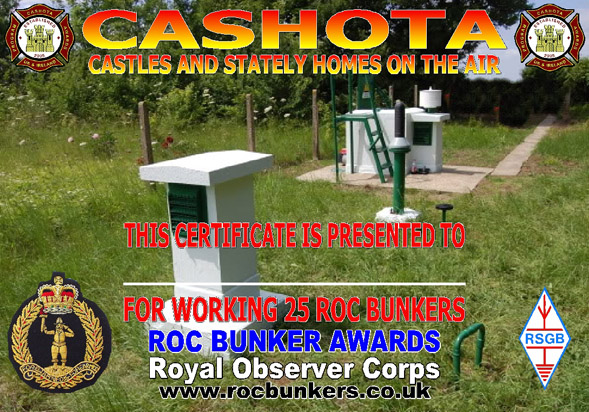
A little history of UKBOTA
Bunkers on the Air (BOTA) began in 2003 as a unique and innovative way to merge the fascinating world of amateur radio with the rich history of military and civil defence bunkers. It offered radio enthusiasts a chance to not only enjoy their hobby in a new and adventurous way but also to explore and bring attention to often-forgotten historical sites.
In the UK, this initiative took on a particular focus on the activation of Royal Observer Corps (ROC) posts—small, often hidden structures that once formed a vital part of Britain’s Cold War defence system. These sites, scattered across the country, have become symbolic of a time when vigilance and communication were at the heart of national security.
The original concept of activating bunkers came from Brian G8GMU and his grandson Joshua M3HBM, who, alongside members of the Coventry Amateur Radio Society, began visiting and activating ROC posts in their local area nearly two decades ago. What started as a personal and club-level initiative soon captured the imagination of others in the amateur radio world.
By 2010, this grassroots idea had grown in scope and momentum. It was formally brought under the umbrella of the Castles and Stately Homes on the Air (CASHOTA) scheme by Chris Darlington M0DOL, a key figure in developing and structuring portable radio events in the UK. Chris’s work helped standardize the process of “activating” historical locations, encouraging participation, logging, and public engagement. His vision was instrumental in setting the groundwork for what UKBOTA would become.
We owe a great deal to the early pioneers of BOTA and related initiatives. Their enthusiasm, dedication, and technical expertise not only preserved important historical heritage but also breathed new life into amateur radio for a new generation. Their contributions laid a solid foundation for the programme’s continued success.

In October 2023, exactly 20 years after the very first UK BOTA activation, the programme saw a powerful and symbolic revival. A special UKBOTA event was held to mark the anniversary, with a particular focus on Royal Observer Corps posts. This event was more than just a celebration—it was a tribute to M0DOL (SK), whose vision and leadership played a critical role in the evolution of BOTA into a recognized and respected part of the amateur radio landscape. It was described by many as “a phoenix rising from the ashes,” as the community came together to breathe new life into the programme.
What followed has been nothing short of extraordinary.
In just 18 months since its revival, UKBOTA has experienced phenomenal growth. What began as a national effort has now inspired a global movement. Activators across the UK—and increasingly, around the world—have embraced the mission of bringing history and radio together.
Today, the broader BOTA programme includes participants from 18 countries, and this number continues to grow. Each activation is more than a radio contact; it’s a moment of historical remembrance, community engagement, and technical skill.
In that short time, UKBOTA activators have:
Activated over 6,000 bunkers
Logged more than 250,000 QSOs (radio contacts)
Established best practices for safe, respectful site visits
Created a supportive network of operators, historians, and preservationists
Inspired younger generations to explore both amateur radio and Cold War history
These numbers reflect not only the enthusiasm of individual operators but also the strength of the community that has rallied around this concept.
As UKBOTA continues to evolve, its mission remains clear: to celebrate and preserve our shared history, to promote portable amateur radio operation, and to foster international collaboration. With ongoing support, the programme aims to expand its educational outreach, enhance digital logging tools, and encourage new activators to explore the stories behind the sites they visit.
Whether you’re an experienced operator, a newcomer to radio, or simply someone with an interest in Cold War history, UKBOTA offers a unique way to connect—with the past, with the airwaves, and with each other.
We invite you to join us as we continue to explore the bunkers, shelters, and hidden outposts that shaped our history—and to keep their stories alive, one contact at a time.

UKBOTA Social Media

Near a bunker?
Check by using the excellent mapping software by Steven M1SDH (UK Ham Portable Map) using the map thumbnail below. For a full screen view click here.
Live bunker spots
Check by using the excellent fieldspotter.radio application by Ian M0TRT using the map thumbnail below. For a full screen view click here.
UKBOTA Bunker Wiki
Planning an activation? Check out our Bunker Wiki and see if there is any information on previous activations of your intended activation site here.
UKBOTA Admin Team
The Boss -M0DXT (Bill)
Web & References – M0ICR (Carl)
Awards – M0XIC (Mark)
Communications – 2E0JIV (Jason)
API & Cluster Magic – M1SDH (Steven)
Email for awards:
awards @ ukbota.org
Need to contact us?
For general information email us at info.ukbota@gmail.com

Hot Links
M0TRT (Ian) page, the home of fieldspotter.radio and other useful applications here
Ham2K portable logger (PoLo) here
G5STU (Stuart) Station Master page here
Station Master GO (Portable) here
G5TM (Tim) YouTube channel, lots of antenna and portable operation ideas here
K4OGO (Salty Walt) YouTube channel, more antenna and portable operation ideas here

(C) 2025 UKBOTA – UK Bunkers on the Air